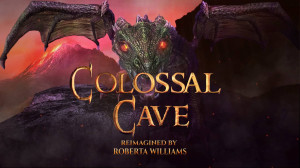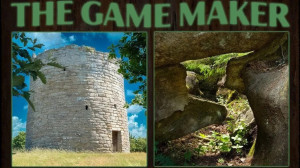Review for Colossal Cave
__big.jpg)
Colossal Cave is remarkable on two main fronts. Not only is it a modern 3D reimagining of the monumentally influential text adventure game Colossal Cave Adventure, considered by many to be the first ever adventure game since its release in 1976. It also marks the return of Sierra co-founders and industry pioneers Ken and Roberta Williams to game development after a hiatus of over twenty years. It feels fitting that their latest project should be a return to the game that started it all – both for the genre (and interactive fiction at large) and Sierra after it inspired Roberta to design her first game, Mystery House, released in 1980.
As a first-time player with relatively modern gaming sensibilities, I approached Colossal Cave with curious apprehension. Even the most ‘retro’ games I’d played are a good twenty-odd years newer than Colossal Cave Adventure. Ken and Roberta themselves have described some of the game’s puzzles as ‘punishing’. Despite being updated with a user-friendly interface, modern controls, and 3D graphics, the core game – puzzles to dialogue – remains untouched. I wondered if such early design choices could transition successfully to the modern day, however groundbreaking the original game in its time.
Colossal Cave is an adventure game distilled to some of its purest elements – exploration, puzzle-solving, and treasure-seeking. The sparingly described locations in the original text adventure have been creatively yet faithfully reimagined in whimsical 3D. The graphics aren’t cutting edge and animations can appear slightly rough, but this isn’t immersion-breaking. Due to the necessarily rock-heavy setting and lack of interactive features, the environments can feel quite monotonous and bare, however; it’s possible to traverse several areas without finding much, if anything, to interact with. Nevertheless, glimpsing the mysterious glow of a new area after extended spelunking is a small reward in itself.
The sound design is similarly minimalistic, evoking the feeling of exploring a real cave. Brief, somewhat forgettable musical cues aligning with new area themes occasionally play on entering. Otherwise, the main sounds are subtle ambient noise, rewarding jingles, and the neutral tones of the dryly humorous narrator.
There’s no real story or defined characters to speak of, only the overarching objectives of finding the cave’s fifteen treasures and returning them to the Wellhouse while attempting to land a perfect score of 350 points. Points are obtained by interacting with and depositing each treasure as well as experiencing certain encounters or events. Points are deducted by reading the instructions, taking hints, quitting or dying. Whether you triumph or meet an untimely end, you’ll be awarded a ranking, from Amateur to Adventurer Grandmaster.
Suppose you’ve never played the game before and skip the instructions to maximize your score, as I initially did. In that case, you are unceremoniously thrust into the game’s world with no introduction, pretext, or immediate guidance other than a view of your immediate surroundings and a succinct voice-over describing them. This can be confusing, motivationally and mechanically, so I’d strongly recommend reading the instructions at first, even though the game effectively discourages you from this with a points penalty (due to the multiple save file requirement, this isn’t as undesirable as it seems).
Even then, it’s unclear who you are or why you’re there – and a game of this age can be forgiven such light worldbuilding. But several important game parameters remain unclear, such as how many treasures there are, whether you’re on the right track, whether time elapses, or what to do after every treasure has been collected. I began to feel a little lost before even entering the labyrinthine cave itself.
Despite concerns about stumbling on the first puzzle, I was pleasantly surprised at my ability to progress – at first. As a player who loves examining every last detail, though, I found few unique hotspots to interact with and a lack of clear differentiation for points of interest, resulting in repeated dialogue. This did not matter much, as I soon had to alter my approach radically.
As I later discovered, every interaction – whether with the hand or eye icon – and every room change count as a ‘turn’. After a certain amount of wanton clicking, the thing I’d dreaded happened – my lantern went out, abruptly ending my adventure. Time, it turned out, was measured in ‘turns’, and I’d exhausted my allowance by being too thorough. This felt quite demoralizing and pressurizing, as not only did I have to start again, but from then on I was cautious not to click on something unless absolutely necessary, inhibiting my willingness to explore.
Inventory management adds a layer of strategic difficulty as only seven items can be carried at a time, making choosing what to take (and when) crucial.
Due to the limited turns available and impressively large map, I soon realized that it would require several runs to fully explore the cave and retrieve every treasure after a laborious process of trial and error, necessitating numerous save files. To ease the burden of starting over, the game includes various codewords, such as the famous ‘Xyzzy’, enabling you to teleport between key locations. Still, repeating actions and backtracking is baked into the classically punitive game design. While you can take knowledge forward into new games, you might not realize you’ve entered an unwinnable state until you’ve depleted your lantern.
Random dwarf encounters add an element of threat, but as they’re all defeated the same way and carry a chance of unavoidably killing you, they’re irritating at best and unfairly punishing at worst if you haven’t saved recently.
Some puzzles have surprisingly straightforward solutions; others are challenging to the point of near impossibility, with some solvable only through chance or trial and error. For example, there is a random chance of certain locations or codewords appearing, so you might have no way of knowing you’ve missed something important. The game isn’t structured so that you’ll find the required items in a relevant area, and the map is basically open-ended, making knowing what to look for and drawing connections between things complicated.
At one point, I found the pirate’s lair before I’d encountered the pirate (a random event), so his room was empty, and I didn’t realize its importance. Other puzzles require solutions that would be difficult to discover organically, sometimes involving actions that aren’t needed or demonstrated elsewhere (the narrator even sternly advises you against trying the solution to one puzzle). Hints alleviate this difficulty but aren’t available when you’re wandering around and struggling with knowing where to go or what to do next – which occupied the bulk of my playtime.
By the end, frustration won out over fun for me. Eventually, I resorted to a walkthrough after getting hopelessly lost and wandering aimlessly around a notorious maze where every room is identical (it turned out this was optional and could be skipped altogether). I felt slightly disappointed in myself but also relieved. There’s a balance to be struck between handholding and motivation-breaking obscurity, and this veered toward the latter. With no real narrative or payoff besides bragging rights, I simply couldn’t justify the hours of strained repetition required to reach the end.
Overall, I appreciated this much more than I enjoyed it; the original game’s influence is undeniable, and its history is fascinating. Evidently, the developers have a genuine love for the original and have put great effort into realizing its world to share their experience with a new generation. While they’ve undoubtedly made it more accessible, this feels like a step back. The best adventure games, including Sierra titles, have taken inspiration from Colossal Cave Adventure – and the many games that followed – and reworked that formula, trimming player-unfriendly relics of older gaming like unintuitive puzzles and unwinnable states. But beneath the new exterior, Colossal Cave is an almost half-century-old game in its bones – and it shows.
WHERE CAN I DOWNLOAD Colossal Cave
Colossal Cave is available at:
We get a small commission from any game you buy through these links (except Steam).Our Verdict:
Despite a lovingly crafted 3D reimagining, Colossal Cave recreates the original too closely to appeal to much more than game history buffs and nostalgia seekers – or very patient players who don’t mind repetitive, arduous gameplay.






























